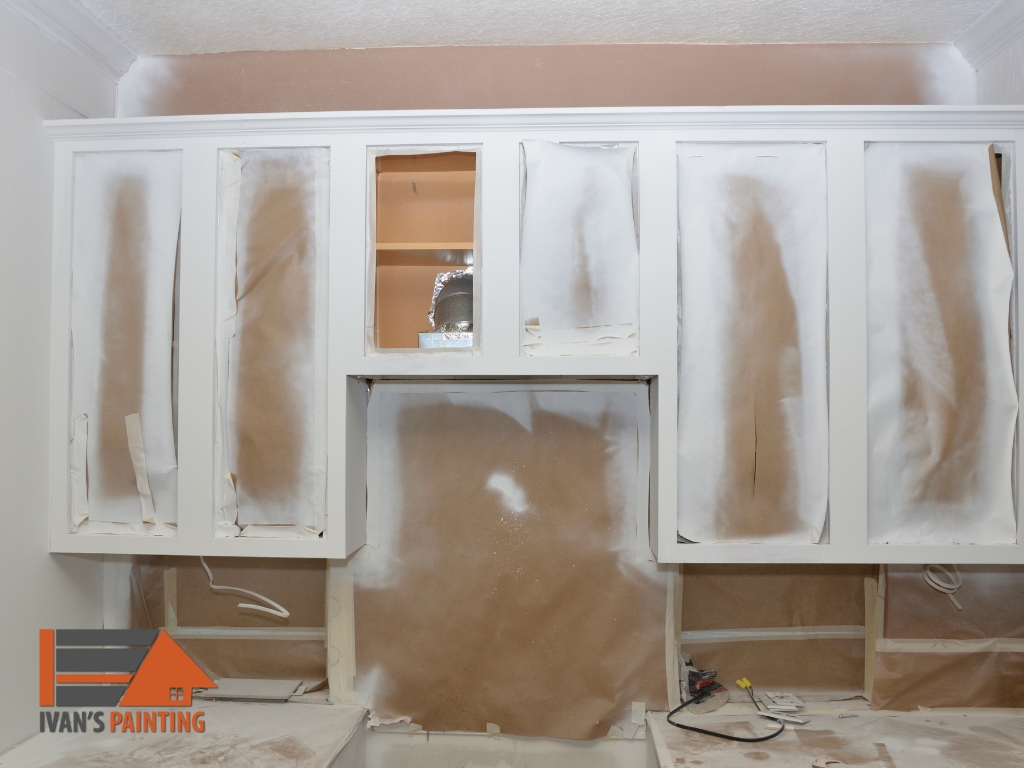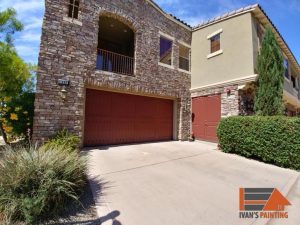Are you looking to revamp your kitchen without the hefty price tag of a complete renovation? Painting cabinet works wonders – breathing new life into your space and providing a fresh and vibrant look.
In this article, we’ll guide you through painting your kitchen cabinets, from preparing your cabinets for a flawless paint job to selecting the right paint and achieving a smooth finish.
Let’s embark on this journey to transform your kitchen.
How to Prep Cabinets for Painting
Before you start your painting project, thoroughly inspect your cabinets. Note any necessary repairs, such as cracks, dents, or loose cabinet hardware. Addressing these issues upfront will ensure a smoother painting process later.
Inspect and Clean Your Cabinets
Before you start your painting project, thoroughly inspect your cabinets. Note any necessary repairs, such as cracks, dents, or loose cabinet hardware. Addressing these issues upfront will ensure a smoother painting process later.
After your inspection, give your cabinets a thorough cleaning. Remove dirt, grease, and grime from the surfaces using warm water and a gentle detergent. Pay extra attention to areas near the stove and sink that accumulate the most residue.
Remove Cabinet Doors and Hardware
Remove all cabinet doors and hardware to make your painting job more manageable. This step lets you paint the cabinet doors and cabinet frames separately, producing a more professional finish. Be sure to label each door and its corresponding location for easy reassembly.
Sand the Surfaces
Creating a smooth, paint-ready surface is essential. Use fine-grit sandpaper to lightly sand the cabinet doors and surfaces. This helps the paint adhere better and provides a professional finish.
Apply a Primer
Primer is a critical step in the process, as it enhances paint adhesion and provides a solid base for the final coat. Opt for a high-quality primer designed for cabinets. Applying primer also prevents stains and wood tannins from bleeding through the paint.
Fill Any Imperfections
After the primer has dried, inspect the surfaces once more. If you notice any imperfections, such as small holes or uneven surfaces, fill them with a wood filler. Sand the patched areas gently once the filler has dried to ensure a smooth finish.
Ultimately, it’s essential to take the time to inspect, clean, and prepare your kitchen cabinets properly before painting will result in a more durable and aesthetically pleasing finish.
What Kind of Paint Do You Use on Cabinets?
Selecting the correct type of paint is crucial for achieving a professional finish when painting your kitchen cabinets. The type of paint you choose will affect your cabinets’ durability, appearance, and longevity.
Here are the primary options to consider:
1. Latex Paint
Latex paint is a popular choice for painting cabinet. It’s water-based, easy to clean up, and dries quickly. Opt for a high-quality latex paint with a satin or semi-gloss finish for cabinets, as it provides a smooth and durable surface resistant to stains and moisture.
2. Oil Based Paint
Oil based paint is known for its durability and smooth finish. Oil paint an excellent choice for high-traffic areas like the kitchen. However, it has a longer drying time, requires proper ventilation, and can be more challenging due to its strong odor.
3. Chalk Paint
Chalk paint is a trendy option that offers a unique matte finish. It doesn’t require much prep work, making it a convenient choice for DIY enthusiasts. However, it may not be as durable as latex or oil based paints, so consider using a sealant to protect the finish.
4. Cabinet-Specific Paints
Some manufacturers offer cabinet-specific paints designed to provide an optimal finish. These paints often have self-leveling properties, making achieving a smooth and professional result easier.
Ultimately, your choice of paint will depend on your preferences and the look you want to achieve. Consider factors like ease of use, drying time, and durability when selecting the best paint for your kitchen cabinets.
Likewise, it’s best to visit a paint store to ensure you get high quality paint in your desired color.
The Benefits of Painting Your Cabinets
Painting kitchen cabinets can be an excellent idea for many reasons, and it’s a cost-effective way to update your kitchen without a complete remodel.
Here are some compelling reasons why you should paint kitchen cabinets:
It’s Cost-Effective
Freshly painted cabinets can be significantly more budget-friendly than replacing all your kitchen cabinets. It allows you to give your kitchen a new look without the hefty price tag of a complete renovation.
It Can Be Customized
Painting your cabinets provides an opportunity to customize your kitchen’s appearance. You can choose any light or dark color that suits your style, making matching your kitchen with the rest of your home decor easier.
It’s Sustainable
Repainting your cabinets is a green choice for home improvement. When you reuse existing cabinets, you help reduce waste and save resources, making it a sustainable option.
Refinishing cabinets instead of getting new ones has less of an environmental impact, cutting down on the energy needed for manufacturing and disposal of materials. This eco-friendly choice not only preserves durable materials in cabinets but is also budget-friendly, offering a cost-effective way to make sustainable improvements to your home.
It Offers Quick Transformation
Painting cabinets is a relatively quick project that can be completed in a matter of days, depending on the size of your kitchen. It’s an efficient way to transform your space without a lengthy renovation process.
It Can Increase Home Value
A well-executed cabinet paint job can enhance your kitchen’s overall appeal, potentially increasing your home’s value.
Whether you’re aiming for a budget-friendly upgrade, a personalized kitchen aesthetic, or a sustainable approach to home improvement, painting your cabinets offers a quick and versatile solution with the added benefit of potentially boosting your home’s resale value.
How To Paint Over My Kitchen Cabinets
The decision to paint kitchen cabinets over your existing kitchen cabinets can be practical, provided you consider several crucial factors.
Here are some valuable tips to help you decide and succeed in this endeavor:
Assess Cabinet Condition
Examine your cabinets closely to determine their condition. If they are structurally sound with only minor wear and tear, you can often proceed with painting over them.
However, if you spot extensive damage, such as deep cracks, major dents, or structural issues, it’s advisable to address these problems first. Repairing or replacing damaged cabinet parts is essential to ensure a professional finish.
Prioritize Proper Preparation
Whether you paint over existing cabinets or not, thorough preparation is the foundation of a successful cabinet painting project. Here’s what you should focus on:
- Cleaning: You can use a tack cloth to ensure your cabinet surfaces are meticulously cleaned and free from dirt, grease, and grime. A clean surface is vital for paint adhesion.
- Sanding: Lightly sand the cabinet surfaces to create a smooth, paint-ready canvas. This helps the paint adhere better and results in a more professional finish. Again use the tack cloth to clean debris in between sanding.
- Primer Application: Applying a high-quality primer is a critical step. It enhances paint adhesion and provides a solid base for the final coat. Moreover, a primer helps prevent stains and wood tannins from bleeding through the paint.
Proper preparation is key to the longevity and quality of your cabinet paint job. Investing time and effort into cleaning, sanding, and priming sets the stage for a more durable and aesthetically pleasing finish.
Rushing through these steps may compromise the overall outcome of your project, so take the time to prioritize the preparation process for the best results.
Mind Your Paint Choice
Your choice of paint can significantly impact the success of painting over existing cabinets. Here’s how to select the right paint:
- Painting Over Existing Paint: If you intend to paint over current paint, ensure the old paint is in good condition. Check for signs of peeling, cracking, or chipping. If the old paint is in good shape, a primer is essential to promote adhesion and create a suitable base for your new paint.
- Stained Wood Cabinets: When dealing with stained wood cabinets, sanding and priming are crucial to prevent the stain from bleeding through the new paint. Using stain-blocking primers is particularly effective in this scenario.
- Color and Finish: Choose a paint color and finish that aligns with your overall kitchen aesthetic. Consider factors such as natural light, the kitchen’s size, and the surrounding space’s color scheme. If you have a small kitchen, it’s best to avoid dark paint as it can make the space appear smaller. Matte and satin finishes are popular for cabinets, as they are durable and easy to clean.
- Quality Matters: Invest in high-quality paint for your cabinets. While it may be tempting to cut costs on paint, a premium product ensures better coverage, durability, and a more professional appearance. This is especially important in high-traffic areas like the kitchen.
- Regular or Cabinet-Specific Paint: Opt for paints formulated explicitly for cabinets or high-traffic areas. These paints often have added features such as increased durability and staining resistance, making them well-suited for kitchen cabinets.
Mindfully choosing your paint and understanding its compatibility with the existing surface is crucial for achieving a successful and long-lasting cabinet painting project. Taking the time to select the right paint for your specific needs ensures a beautiful and enduring result.
Consider Your Desired Outcome
Your desired outcome plays a significant role in deciding whether to paint over your cabinets or opt for a more comprehensive approach. If you aim for a complete color change and a uniform, professional look, it’s generally better to strip the existing paint or finish. Stripping the old paint or finish allows you to begin with a clean slate and achieve a more consistent and high-quality result.
Ultimately, painting over your kitchen cabinets can be viable under specific circumstances, but careful consideration and proper execution are key. Assess the condition of your cabinets, the quality of your current paint or finish, and your desired outcome before deciding.
Remember that diligent preparation, including thorough cleaning, sanding, and priming, along with the appropriate choice of paint, is essential for a successful outcome. Whether you choose to paint over your existing cabinets or opt for a more extensive approach, patience and attention to detail will be your allies in achieving the best results in your cabinet painting project.
How to Get a Smooth Finish When Painting Kitchen Cabinets
When painting kitchen cabinets, achieving a smooth and professional finish requires attention to detail and the right techniques. Here’s how to ensure your cabinets look impeccable:
Use High-Quality Brushes and Rollers
Invest in high-quality brushes and rollers for painting cabinets. Quality tools make a significant difference in the final result.
Apply Thin, Even Coats
Avoid applying a thick layer of paint because it can lead to drips and an uneven finish. Instead, apply multiple thin and even coats of paint, allowing each coat to dry completely before the next one.
Sand Between Coats
Light sanding between each coat of thin paint on the cabinet doors removes any imperfections or brush marks. Use fine-grit sandpaper, and clean the sanding dust before applying the next coat.
Consider using Spray Paint
For a truly professional finish, consider using spray paint. This can provide a smooth and even coat of paint, resulting in a sleek look. Remember to do this on flat surfaces to prevent uneven coating.
Take Your Time
Rushing through the painting process can lead to mistakes and an uneven finish. Patience is key to achieving the best results.
Allow Ample Drying Time
Be patient. You can place your cabinet door on a flat surface and allow the cabinet doors to dry thoroughly between each step. Writing a “wet paint” signage is also best to prevent accidents during this process. Remember, rushing the process can result in damage to the finish.
Takeaway
To paint kitchen cabinets can be a rewarding DIY project. It’s essential to evaluate your skills and the complexity of your cabinet door. If you need more confidence in your abilities to paint cabinets or if it requires extensive repairs or refinishing, seeking professional help may be the best decision.
Professional kitchen cabinet painters have the experience and expertise to ensure a flawless finish and save you time and potential frustrations. They can also guide paint selection, color choices, and other factors that can elevate the overall outcome of your kitchen cabinet transformation.
Ultimately, whether you tackle the project yourself or opt for professional assistance, your goal is to achieve the kitchen of your dreams with new kitchen cabinets. So, take a moment to assess your capabilities and the condition of your cabinets, and make the choice that best aligns with your desired results and peace of mind. Your kitchen can once again become the heart of your home, regardless of the path you choose.




